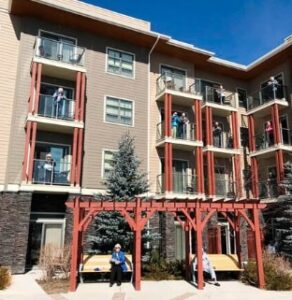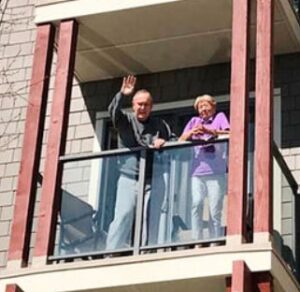Amica Senior Lifestyles Takes On Its Biggest Pain Point
Even a fine-tuned machine needs periodic maintenance—and no more so than when unprecedented performance is demanded of it. Amica Senior Lifestyles, an owner, operator and developer of premium senior living residences in Canada, is confronting that reality as it drives toward its goal of doubling in size in the next five years.
In the past decade, Toronto-based Amica has acquired or built 31 independent-living, assisted-living and memory-care residences in communities across Ontario, British Columbia and Alberta. With ambitious growth targets set for the next decade, Amica already has several key components for success—financing, an experienced senior leadership team and a comprehensive strategic plan—in place, says CEO Douglas MacLatchy. Still, Mr. MacLatchy says he recognized that one component in particular—how the leadership team operates—was in need of some precision adjustment. While the right people are in position, he says, the way they work together must change to support the organization’s aggressive growth goals.

To operate at full capacity, an enterprise must be more than the sum of its parts. Every function—marketing, design, operations and the rest—affects the work of every
other function. Leaders must trust that each team member will communicate in a straightforward and timely fashion so the organization can pursue its goals efficiently and effectively. “We have gotten to the point where we’ve got a pretty darn good machine going,” Mr. MacLatchy says. “But the communication style that we have had in the past just plain and simply won’t work for us in the future because the volume and pace of development is so different.”
Mr. MacLatchy’s insight into that potential barrier to success reflects extensive leadership experience in the banking, real estate and senior living sectors—including as the founder of two companies and the chief coordinator of a real-estate investment trust’s initial public offering, which gave investors a return of 37%.
In 2010, Mr. MacLatchy founded BayBridge Senior Living to buy and operate senior living residences. Five years later, BayBridge acquired Amica Mature Lifestyles and restructured the enterprise.
Rebranded as Amica Senior Lifestyles, the company tightened its focus on the high end of the senior living market. It divested properties that did not fit the business model and pivoted away from its strategy of growing through acquisitions. Since 2015, almost all of the company’s expansion has been through greenfield developments.
Amica now serves nearly 5,300 residents. In the next five years, Mr. MacLatchy expects to deploy approximately $2 billion to essentially double the size of the company’s holdings. “Our pace of asset growth is at least double but it’s probably four to six times the activity level,” he says.
Future growth will come entirely from ground-up developments rather than acquisitions, Mr. MacLatchy says, and the previous incremental, slow-and-steady pace will be replaced by having several projects underway simultaneously. The company also plans to expand into new markets in Canada and, for the first time, enter markets abroad.
Preparing the Track
Much of 2019 for Amica was devoted to evaluating opportunities for expansion that would produce profits similar to those generated by the company’s current assets. The leadership team considered various markets, price points, service offerings and other options before arriving at an important conclusion.
“We decided we would stick to our game,” Mr. MacLatchy says. “We’ve had great success to date on executing in our niche and felt that we should continue to do that as opposed to going in different directions.” Share on X
That decision led to another point of clarity. “If we look past five years, we will need to be in new markets because the opportunities for new site generation in our current market are not going to be sufficient for the pace at which we want to grow,” Mr. MacLatchy says.
Amica leaders cast a wide net, exploring about 20 countries in North America, South America, Europe and Asia in search of market opportunities that tracked with the company’s growth plan and operating structure.
By early 2020, that plan was coming into sharp focus: Between 90% and 95% of Amica’s expansion in the next five years will be in Canada, with the rest in London to establish a toehold for the company in the United Kingdom. “For our Canadian pipeline of growth, we know where we’re going to be putting shovels in the ground for the next five years,” Mr. MacLatchy says. “We know who our development partners are going to be, what percentage ownership they’re going to have, how big those properties are and what our service offering is going to be. Now it’s a matter of executing on our plan.”
The Challenge at Hand
Amica’s leadership team is accustomed to certain routines essential for success in the senior living business. About one-third of the residential units at each property need to be refilled each year, which requires continuous sales and marketing efforts. To accommodate staff turnover and the addition of new employees for new residences, the company typically hires and trains between 600 and 800 workers each year.
“Just maintaining is quite a mammoth exercise,” Mr. MacLatchy says. Developing a new senior residence has its own rhythm. In most jurisdictions in Canada, going through the entitlement process needed to build on a greenfield site takes a couple of years. During that time, members of Amica’s senior leadership team work with designers, architects, local community groups, municipal planning staff and local politicians to get needed approvals in place.
 Meanwhile, the same team is working with architects, both internal and external, on the detailed plans for the new building and with Amica’s development partners to keep everything moving forward. By the last year of construction, sales and marketing and operations protocols have fully ramped up to ensure that all units are leased and ready for move-in.
Meanwhile, the same team is working with architects, both internal and external, on the detailed plans for the new building and with Amica’s development partners to keep everything moving forward. By the last year of construction, sales and marketing and operations protocols have fully ramped up to ensure that all units are leased and ready for move-in.
The entire process—from finding the site to having the residence fully occupied—takes five to seven years. Most of the 15 members of Amica’s senior leadership team are involved in multiple stages of the process, assessing the project’s economics, finetuning the new building’s size and design, and articulating the services to be offered. Most steps are iterative; for example, the economics of each property might be tested 30 times over the seven-year development period, and it is common for a project to go through 20 or more design revisions.
“Each time, we bring together operations people, design people, construction people, and sales and marketing to revisit our assumptions,” Mr. MacLatchy says. “So communication between various expertise groups within the company is not only iterative and repetitive, but it’s vitally important to the success of that project.”
“Communication between various expertise groups within the company is not only iterative and repetitive, but it’s vitally important to the success of that project.” —Douglas MacLatchy, CEO, Amica Senior Lifestyles
Amica has mastered the work streams associated with developing one new property at a time. Going forward, Mr. MacLatchy intends to start between four and seven properties per year, which will create a matrix of projects at various stages of development—and complex, multifaceted accountabilities for members of the senior leadership team.
Despite his confidence in his leadership team, Mr. MacLatchy was concerned that the way team members worked together jeopardized Amica’s ability to juggle the demands associated with multiple projects underway simultaneously.
“I asked each of the functional groups in the company, ‘Have you got more bandwidth and capacity to do more if we grow this company?’ and every one of them said ‘Yes, we can handle more,’” he says. “And yet we were not even able to keep up with what we had been doing.”
To explore why, Insigniam conducted an organizational assessment based on interviews with members of the senior leadership team and other employees across the organization to get their perspective on Amica’s challenges and opportunities.
The assessment revealed that the strengths of individual leaders have not always aligned in such a way as to optimize the company’s development capacity.
When leaders have a “silo mentality” and fail to consider how their decisions and timelines affect other parts of the organization, the overall enterprise is less efficient and effective than it can be. “Doug and the Amica leadership team had the wisdom to understand that bold growth ambitions are not going to be achieved with merely more resources and more effort,” says Jon Kleinman, a partner with Insigniam. “The system needed to transform to perform in a way that generates an exponential change. 1+1+1 must be transformed to 3×3. That begins with a transformation in leadership.”
Full Speed Ahead
Mr. MacLatchy shares high praise for—and expresses strong confidence in—the leadership team Amica has built. With strong financial backing at his disposal for several years, Mr. MacLatchy has sought to recruit highperforming individuals with the vision and focus to skillfully apply their expertise in service of helping the company meet its growth goals.
“I’m not about to lose the talent that I hired in here and the expertise that we have gained in working together over time,” he says. “What I need to do is tweak the process of how we work together and increase the horizontal collaboration between the various disciplines within the organization in order to be more effective at the pace that I want to run at.” Insigniam’s organizational assessment backed up Mr. MacLatchy’s idea.
“Individually, they are strong in their technical expertise, but [they are] often more focused on just their area of expertise rather than how their work impacts the whole business,” Mr. Kleinman says.
In response, Insigniam facilitated dedicated working sessions to support the requisite transformation. In these discussions the concept of “your word is your bond” in particular resonated with the team, Mr. MacLatchy says. “The very next week after that session, how I handled meetings and how my senior leadership team responded in those meetings was different,” he says. “Everybody was communicating face-up.”
Senior leaders learned why, from a business perspective, it is crucial for them to be honest and direct with colleagues rather than to pay lip service to commitments that are not realistically attainable. “Your word is your bond” emphasizes the practice of proactively communicating in the event that a deadline or other commitment is likely to be missed so that colleagues can have the timely and accurate information they need to manage their own work accordingly. “That has been a huge change in terms of everyone feeling that they are being treated honestly and respectfully,” Mr. MacLatchy says.
A two-day working retreat organized by Insigniam gave team members the opportunity to step away from their dayto-day responsibilities to examine their working relationships and their assumptions and acquired beliefs about “how the work must get done.” Says Mr. Kleinman: “They reconnected in terms of their trust and respect for one another and reimagined their process for going to market with new residences.”
That event reminded Mr. MacLatchy that the fast pace required for an aggressive growth plan must be balanced with breaks that allow team members to get to know each other as people and intentionally address how the work will get done. “It reminded us of the common bond and culture that was really the reason that we all wanted to come here and work together in the first place,” he says.
 In April, Amica Senior Lifestyles CEO Douglas MacLatchy recorded a video message to reassure members of the Amica community—his first time communicating with stakeholders in that way. “We want you to know we are caring for our residents the same way we would our own family—that is my personal commitment to you,” he said. Mr. MacLatchy added that the company had “engaged leading experts and put protocols in place at every level to protect the health and well-being of every resident and team member.” The company also reported in April on expanded coronavirus testing in place at Amica facilities and noted that staff who tested positive were paid while they recovered at home.
In April, Amica Senior Lifestyles CEO Douglas MacLatchy recorded a video message to reassure members of the Amica community—his first time communicating with stakeholders in that way. “We want you to know we are caring for our residents the same way we would our own family—that is my personal commitment to you,” he said. Mr. MacLatchy added that the company had “engaged leading experts and put protocols in place at every level to protect the health and well-being of every resident and team member.” The company also reported in April on expanded coronavirus testing in place at Amica facilities and noted that staff who tested positive were paid while they recovered at home.


